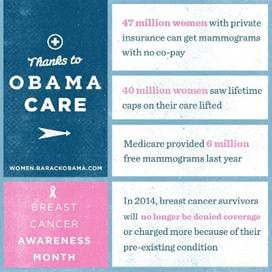With its deliberately lilac colours and pretty, cursive script, everything about Women for Obama, from its logo to campaign techniques has been designed to appeal to American women. Established in 2007, firstly to take feminists away from Democrat rival, Hillary Clinton, and then to shore up the women’s vote during the Presidential campaign trail, Women for Obama is, once again, winning the women’s vote for Barack Obama.
According to the Pew Research Centre, the President now enjoys a 20% lead over rival, Mitt Romney, with women voters. The Obama gender gap – he won the women’s vote by 13% in 2008 – has widened in 2012 with many pollsters tipping women will deliver victory to Obama. Social media stats parallel the latest polls. 1,047,318 people LIKE Women for Obama on facebook; Women for Mitt manages only a quarter of that number.
Yesterday, during the first of three debates between the candidates, both men opened with an appeal to women voters. Obama paid respect to his wife, their wedding anniversary and his grandmother; Romney talked political encounters with women on the campaign trail. Both campaigns are using targeted techniques to attract women voters. Examining where Obama gets it right, and Romney wrong, is a valuable lesson in gender-based campaigning.
Gender Based Campaign Lesson 1. The Political Visual
The use of visual images, symbols and diagrams to explain complicated, interconnected social problems to time poor women voters is a key in gender-based campaigning. In today’s visual age, where everything from online shopping to socialising is app accessible, political visuals explain systemic issues quicker than a thousand speechwriters can. Both the Obama and the Romney campaign have been using them with women.
Here Women for Obama, explains the benefits of Obamacare to breast cancer sufferers and carers:
And here Women for Obama outlines the threat Romney poses to reproductive freedom.
Women for Mitt made the most of Obama-Biden Deputy Campaign Director, Stephanie Cutter’s recent comments that “women don’t care about the last four years, they care about what’s going to happen in the next four years”; not with speeches, but this image:
And when talking about the impact of Obama economic policies on women; Women for Mitt promote it like this:
Although both campaigns are using these techniques now, it is clear one understands niche marketing better than the other. Women for Obama’s most successful political visual are not about policy or vitriol but about cultivating a sense of community amongst women. They use cartoons and humour; memes and e-cards with a broad, soft-feminist appeal. In the way Cosmo transforms a new shade of Clarins lipstick from a want to a need; Women for Obama political visuals make an Obama vote a fashion accessory.
This one, for instance, has one of the highest LIKES on social media.
Romney’s political visual campaign features far fewer cartoons. It prefers photographs of crowds of real women, all holding up Women for Mitt banners. The message is clear – “Hey ladies, you can vote for me. There are others just like you who do.”
Romney has had more success garnering support from women through moving images. His Dear Daughter ads, have been viewed by over 174,000 people on YouTube and given prime time air across the country. The appeal to women is obvious pretty, babypink soft-focus lighting; bathing a beautiful baby-girl. While the overt message is on the intergenerational consequences of Obama debt, the dog-whistle is on abortion. Dear Daughter aligns Romney to the economic rights, as well as the right to life, of the unborn.
Women’s Agenda sister site Crikey has featured the Life of Julia, a political cartoon commissioned by Obama&Biden2012 exploring the impact of government policies on a fictional American woman. The Life of Maggie is the Pro-Life Family’s take on the same issues. Each of cartoon explains more effectively than a stump speech or a debate what each candidate means for women.
Gender-based Campaign Lesson 2: The celebrity endorsement.
Women pay attention to what celebrity women do. Like men have innate recall of sports star stats and car makes and models, women know the details of the Katie and Tom divorce settlement and why Kristen is cheating on Robert.
Women for Obama is master of the celebrity endorsement. Famous women line up in their droves to back Barack. Natalie Portman, Ashley Judd and Beyonce have all recorded videos for the campaign. Scarlett Johansson, Eva Longoria and Mary J Blige appeared at the Democratic Convention 2012. Sarah Jessica-Parker fundraised for him in New York. It’s pretty clear where the Sex and the City generation lines up.
Women for Mitt, on the other hand, has Jenna Jameson, porn star turned entrepreneur. And Clint Eastwood.
Gender-based Campaign Lesson 3: Gender mainstreaming of women’s policy
For Obama-Biden2012, women’s policy is indivisible from the central policy focus of the re-election campaign. Selling Obamacare and promoting a role for government in economic management and wealth redistribution are both issues of tremendous political value to women. It is, after all, upon the shoulders of women that the care of the young, aged, disabled and veterans fall when government fails to provide support to those who cannot care for themselves.
When a campaign promises to deliver equal pay for women and to shift the healthcare burden off individual families and onto a state-run scheme; women listen. It’s in their interests as care givers to ensure both the spoils and the burdens of life are shared fairly.
Women for Mitt suffers from the Republican’s long term disconnection to the feminist movement. The campaign is estranged from the history of women’s suffrage and fails to grasp that first wave feminists didn’t campaign for the right to vote just so it could be business as usual with a Green, White and Violet hue. Before suffrage, it was women providing the volunteer labour and charitable funds to support orphanages, schools and hospitals. The rise in the women’s vote has paralleled the shifting of the burden of care from women onto the state and the economy.
This is the single greatest challenge for the Women for Mitt campaign, and neo-liberals/conservatives in general. They fail to recognise that macro-economics is understood by women through the prism of micro-economics; the politics of the household budget and their own unique sphere of influence. When historically so much of women’s work is unpaid and outside economic value; it’s no wonder reducing everything to monetary terms – reducing debt at all other costs – disconnects with women voters.
For women, the choice has been clear for some time. Barack Obama (and the Democrats) embody a care economy; Mitt Romney (and the Republicans) a laissez faire economy. The Democrat campaign is feminised around the care principle – whether it’s Obamacare, support for veterans or funding for education – and it’s a bold move where women are central to bringing victory home. Care is not a natural narrative framework for pro-business, pro-military, pro-tax cut Republicans.
Escaping the confines of this political shorthand is not easy. This is why Romney spent the majority of his time in the debate yesterday selling himself as Republican Lite; a former Massachusetts Governor with a commitment to healthcare and education. It was a strong performance, but unlikely to overcome the long term alignment of his party to individualism and self-suffiency.
All this means that the Democrats have finally started to leverage their long term alignment to the program of the women’s rights movement. That’s why the most important campaign theme for Women for Obama is this:
The long term investment by the Democrats in promoting women’s rights is transforming into an election winning advantage.
There are other interesting lessons in gender based campaigning to learn from the US presidential race that I don’t have time to talk about here; such as the importance of merchandise (See Women for Obama Campaign merchandise) and the use of gendered displays of love and devotion; the political equivalent of the popular book, Porn for Women. But there is not enough space for that now.












